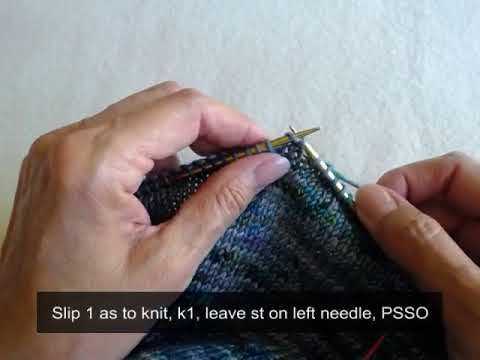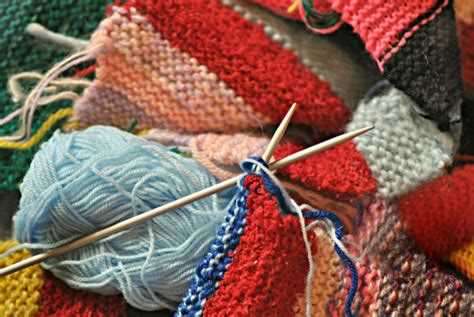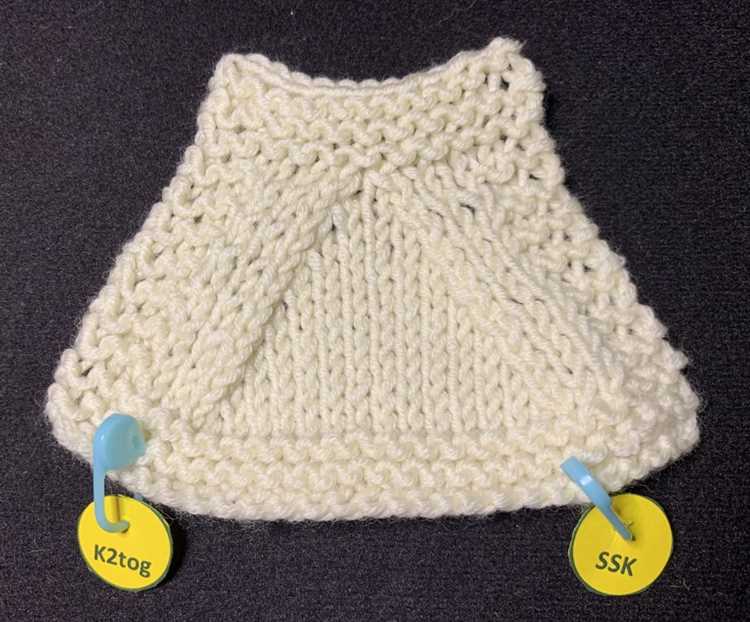Knitting is a wonderful craft that allows you to create beautiful and functional items using just yarn and a pair of needles. However, it can be overwhelming for beginners with all the different stitches and techniques to learn. One common stitch that you may come across in knitting patterns is the SSK, or Slip Slip Knit, stitch.
The SSK stitch is a decrease stitch that is used to shape your knitting by reducing the number of stitches on your needles. It creates a left-leaning decrease and is often used in lace patterns, garment shaping, and creating decorative details. While it may seem complicated at first, with a little practice, the SSK stitch will become an essential part of your knitting repertoire.
To work the SSK stitch, you will need to slip two stitches, one at a time, from your left-hand needle to your right-hand needle as if you were going to knit them. Then, insert your left-hand needle into the front loop of those two slipped stitches and knit them together. This creates a decrease and gives the stitch its left-leaning characteristic.
The SSK stitch is often used in conjunction with other stitches and techniques to create intricate patterns and designs. By mastering this stitch, you will open up a whole world of possibilities in your knitting projects. So grab your needles and yarn, and give the SSK stitch a try! Happy knitting!
What is the Slip Slip Knit Stitch?
The Slip Slip Knit (SSK) stitch is a commonly used technique in knitting that involves decreasing stitches. It is often used to shape and create angles in knitted garments or accessories, such as sleeves, necklines, or decorative patterns.
The SSK stitch is a combination of three individual knitting movements: slipping stitches, knitting stitches, and passing slipped stitches over. It is usually worked on the right side of the knitting, but can also be worked on the wrong side for specific stitch patterns or designs.
When working the SSK stitch, follow these steps:
- Slip the first stitch from the left needle to the right needle without knitting it.
- Slip the second stitch from the left needle to the right needle without knitting it.
- Insert the left needle knitwise into the front loops of the slipped stitches.
- Wrap the working yarn counterclockwise around the right needle, as if to knit.
- Slide the right needle through the front loops of the slipped stitches, knitting them together.
- Slide the two slipped stitches off the left needle, completing the SSK stitch.
The SSK stitch creates a left-leaning decrease, meaning the stitches slope to the left when viewed from the right side of the knitting. It is often used in conjunction with the knit two together (K2tog) stitch, which produces a right-leaning decrease, to create more intricate stitch patterns and shaping.
Learning how to perform the SSK stitch is an essential skill for knitters of all levels, as it is commonly used in patterns and can add detail and texture to finished projects.
The Purpose of Slip Slip Knit Stitch in Knitting
The slip slip knit (ssk) stitch is a common knitting technique used to decrease the number of stitches in a row. It is often used to create shaping in knitting patterns, such as decreasing the width of a garment or forming a decorative edge.
The ssk stitch is particularly useful when knitting garments that require a smooth and seamless finish. This stitch creates a left-leaning decrease that is nearly invisible, allowing the knitter to achieve a more professional and polished look.
By slipping two stitches individually and then knitting them together through the back loop, the ssk stitch decreases the number of stitches by one. This decrease can be used to shape sleeves, necklines, and other areas of a knitted project where a gradual decrease is desired.
The ssk stitch is commonly used in lace knitting and other delicate knitting patterns. It helps create intricate lace patterns by decreasing the number of stitches in a row, allowing the lace pattern to take shape. It also helps in preventing visible holes in the lacework by maintaining the continuity of the pattern.
When working with the ssk stitch, it is important to maintain tension and consistency throughout the project. This will ensure that the decreases are evenly spaced and create a smooth and balanced appearance in the finished piece.
- To work the ssk stitch:
- Slip the first stitch as if to knit.
- Slip the second stitch as if to knit.
- Insert the left needle into the front loops of the two slipped stitches.
- Knit the two stitches together through the back loop.
The slip slip knit stitch is a valuable technique for knitters of all levels. By mastering this stitch, knitters can add shaping, decrease stitches, and create beautiful lace patterns in their projects.
How to Perform the Slip Slip Knit Stitch
The slip slip knit stitch, commonly abbreviated as SSK, is a basic knitting technique that involves manipulating stitches to create a decrease. This stitch is often used to shape the fabric, create lace patterns, or enhance the design of a project.
To perform the slip slip knit stitch, follow these steps:
- Insert the right needle into the first stitch on the left needle as if to knit.
- Instead of knitting the stitch, slip it from the left needle to the right needle without doing anything else.
- Repeat steps 1 and 2 with the second stitch on the left needle.
- Insert the left needle back into the front of both slipped stitches from left to right.
- While holding the slipped stitches with the left needle, insert the right needle into the front of both stitches from left to right and knit them together.
When performed correctly, the slip slip knit stitch creates a left-leaning decrease and reduces the total number of stitches on the needle.
Here is a step-by-step breakdown of the slip slip knit stitch:
- Insert right needle into the first stitch on the left needle as if to knit.
- Slip the stitch from the left needle to the right needle without knitting it.
- Insert right needle into the second stitch on the left needle as if to knit.
- Slip the stitch from the left needle to the right needle without knitting it.
- Insert left needle back into both slipped stitches from left to right.
- Insert right needle into the front of both stitches from left to right.
- Knit both stitches together.
The slip slip knit stitch can be a valuable addition to your knitting skills. It allows you to create decorative decreases and shape your knitting projects with precision.
Understanding the Anatomy of the Slip Slip Knit Stitch
The slip slip knit stitch, often abbreviated as SSK, is a commonly used technique in knitting. It is a decrease stitch that is often used to create shaping in a knitted garment, such as decreasing stitches for sleeves or shaping a neckline.
The SSK stitch is performed by slipping two stitches from the left needle onto the right needle as if to knit, and then knitting them together through the back loops. This creates a left-slanting decrease, which can be visually appealing and can add a nice texture to your knitting project.
Let’s break down the anatomy of the slip slip knit stitch:
- Slip: The first step of the SSK stitch is to slip two stitches from the left needle to the right needle. This is done by inserting the right needle into the first stitch on the left needle as if to knit, and sliding it off the left needle. Repeat the same process for the second stitch.
- Slip: After slipping the two stitches, they will now be on the right needle.
- Knit: To complete the SSK stitch, insert the left needle into the front loops of both slipped stitches from left to right. Wrap the working yarn around the right needle, and pull it through the two stitches as if knitting.
It’s important to note that the SSK stitch creates a left-slanting decrease because the stitches are worked through the back loops. This can create a nice visual effect when used in combination with other decrease stitches.
The slip slip knit stitch is a versatile technique that can be used in various knitting patterns. It is commonly used in lace knitting, as well as in shaping garments. Once you understand the anatomy of the stitch and practice it a few times, you’ll be able to incorporate it into your knitting projects with ease.
Advantages of Using the Slip Slip Knit Stitch
The Slip Slip Knit (SSK) stitch is a popular technique in knitting that offers several advantages to knitters. Here are some reasons why you should consider using the SSK stitch in your knitting projects:
- Neater Decreases: The SSK stitch results in a neater decrease compared to other decrease stitches like k2tog (knit 2 together). The SSK stitch creates a left-leaning decrease that is often used to shape garments and create attractive designs.
- Smooth Transition: When working on pattern stitches, the SSK stitch allows for a smoother transition between stitches. By using the slip slip knit technique, the stitches blend seamlessly without creating a bulky or uneven appearance.
- Reduced Tension: The SSK stitch helps alleviate tension in knitted fabric. By slipping two stitches and then knitting them together, the resulting decrease is looser and more elastic, making it a great choice for garments or items that need to stretch or have a bit of give.
- Enhanced Design Flexibility: The SSK stitch opens up possibilities for creating unique stitch patterns, lacework, and intricate designs. Its left-leaning orientation allows knitters to create curves, twists, and other interesting shapes in their projects.
- Compatible with Different Projects: The Slip Slip Knit stitch can be used in a wide range of knitting projects, such as scarves, hats, sweaters, and shawls. Its versatility makes it a valuable addition to any knitter’s repertoire.
Overall, the Slip Slip Knit stitch offers both technical and design advantages in knitting. Whether you’re a beginner knitter or an experienced one, mastering the SSK stitch can bring new dimensions to your knitting projects.
Common Mistakes to Avoid when Working the Slip Slip Knit Stitch
When learning how to knit, the slip slip knit (SSK) stitch is one of the essential techniques to master. However, it can be challenging for beginners. To help you avoid frustration and ensure successful results, here are some common mistakes to watch out for when working the SSK stitch.
- Not slipping the stitches correctly: The first step in the SSK stitch is to slip two stitches from the left needle to the right needle. It’s crucial to slip them one by one in the correct direction, inserting the right needle into the front loop of each stitch. Make sure not to accidentally twist the stitches or skip this step altogether.
- Knitting the slipped stitches separately: After slipping the stitches, it’s important to knit them together as a single unit. Some beginners may mistakenly knit the slipped stitches individually, resulting in an incorrect stitch and an uneven appearance.
- Knitting the wrong stitches together: When knitting the slipped stitches together, make sure to knit the second slipped stitch before the first slipped stitch. This sequence is essential to create the correct left-leaning angle in the finished stitch. Switching the order can result in a different stitch and affect the overall look of your project.
- Not paying attention to tension: Tension is crucial in knitting, and it becomes even more important when working the SSK stitch. Make sure to maintain an even tension throughout the stitch, avoiding tight or loose stitches. Inconsistent tension can distort the shape of the stitch and disrupt the overall pattern.
- Misinterpreting pattern instructions: When following a knitting pattern, it’s essential to understand the instructions for the SSK stitch. Different patterns may use different abbreviations or variations of the stitch. Always read the pattern carefully and ensure you are working the SSK stitch correctly according to the given instructions.
Avoiding these common mistakes will help you achieve clean, neat, and professional-looking SSK stitches. With practice and attention to detail, you’ll soon become comfortable and confident in working this essential knitting technique.
Tips and Tricks for Perfecting the Slip Slip Knit Stitch
The slip slip knit stitch (SSK) is a commonly used knitting technique that creates a decrease in stitches and is often used to shape garments or create decorative patterns. While it may seem simple, there are a few tips and tricks that can help you perfect your SSK stitch.
- 1. Use the correct needles: To achieve an even and neat SSK stitch, it’s important to use the right kind of needles. Choose needles with a sharp point, such as bamboo or metal, which will help you easily maneuver the stitches.
- 2. Keep your tension consistent: Consistent tension is key to creating polished and uniform stitches. Pay attention to the amount of tension you apply while knitting and make sure it is the same for each stitch in the SSK sequence.
- 3. Practice the slip: Before you begin the SSK stitch, practice slipping stitches one at a time to get comfortable with the movement. This will help you avoid any accidental dropped stitches or snags in your work.
- 4. Keep your stitches loose: When working the SSK, it’s important to keep your stitches loose to avoid creating a tight, puckered fabric. Make sure you have enough give in your stitches to maintain an even tension throughout your work.
- 5. Pay attention to stitch orientation: When performing the SSK, it’s important to slip the stitches in the correct orientation. Slipping the stitches incorrectly can result in twisted stitches or a distorted stitch pattern.
By following these tips and tricks, you’ll be on your way to mastering the slip slip knit stitch. Remember, practice makes perfect, so don’t be afraid to experiment and refine your technique until you achieve the desired result.
Projects and Patterns that Utilize the Slip Slip Knit Stitch
The slip slip knit (SSK) stitch is a versatile knitting technique that allows you to create various textures and designs in your knitting projects. Here are a few patterns and projects that make use of the SSK stitch:
- Basic Scarf: A simple and beginner-friendly project, a basic scarf can be enhanced with the use of the slip slip knit stitch. By incorporating the SSK stitch in certain sections, you can add a unique twist to the design.
- Lace Shawl: Lace knitting often incorporates different types of decreases to create intricate patterns. The slip slip knit stitch is frequently used in lace shawl patterns to create beautiful designs and delicate motifs.
- Mittens: Knitted mittens are a popular project, and the slip slip knit stitch can be used to shape the thumb gusset or create decorative elements on the back of the hand.
- Socks: Socks are another project where the slip slip knit stitch can come in handy. It can be used to shape the heel or create interesting patterns on the leg or foot of the sock.
- Colorwork Accessories: The slip slip knit stitch can be used in colorwork projects to create unique designs and patterns. By combining different colors and utilizing the SSK stitch, you can create beautiful accessories like hats, cowls, or even sweaters.
Incorporating the slip slip knit stitch in your knitting projects opens up a world of possibilities. Whether you’re a beginner or an experienced knitter, experimenting with the SSK stitch can add texture, shape, and visual interest to your creations.
FAQ:
What is SSK in knitting?
SSK stands for “slip, slip, knit”, it is a technique used in knitting to decrease stitches.
What is the purpose of doing an SSK stitch in knitting?
The purpose of doing an SSK stitch is to decrease the number of stitches in a row, creating a slanting decrease that leans to the left.
When should I use the SSK stitch in my knitting projects?
The SSK stitch is commonly used in patterns where a slanting decrease is desired. It is often used in lace knitting, sock knitting, and garment shaping.
What is the difference between SSK and K2tog?
The SSK and K2tog are both decrease stitches, but they have different effects on the knitted fabric. SSK creates a left-leaning decrease, while K2tog creates a right-leaning decrease.
Can you provide any visual resources to help me understand the SSK stitch better?
Yes, there are many video tutorials available online that demonstrate how to do the SSK stitch. You can search for “how to do SSK in knitting” on video-sharing platforms like YouTube to find helpful resources.


